See also: the LATTEY Galilean sights on the SMLE.....GIBBS Galilean sights for the SMLE...
MARTIN Galilean sights for the SMLE .........BSA optical sight on a Lee-Metford
Drag horizontally to rotate subject. Click to zoom and drag to pan. Full screen viewing from expansion arrows.
The Neill sight system, latterly named for Barnett,
was approved for use militarily on 28th. September 1915,
at the same time as the equivalent Lattey sights,
and entered into the List of Changes as the Mark I version,
and the entry included the usual description and basic fittting instructions.
17557—Sights, Optical (Neill), Mark I. ......................... 28 Sep 1915
Rifles, short, M.L.E.
Back: ....................................... ....................................... LWith lens and bush, and aperture plate with
fixing screw, two washers, and elevation plate.
Front: ....................................... ....................................... LWith lens and bush, and clamping plate with
fly-nut and washer.Introduction.
............Patterns of the above-mentioned sights have been approved to govern supplies as may be ordered.
............Backsight: The backsight consists of a frame into which a bush, fitted with a lens, is screwed, and an adjustable aperture plate with a pivoted elevation plate fitted on the rear face and fixed by a screw and two washers.
............The backsight is fitted on the left side of the rifle under the
spring of the long range aperture sight, and replaces the long range
aperture sight. To allow the backsight to fold down horizontally when not in use, a suitable clearance will be cut in the stock, fore-end
............A few backsights of early supply were graduated for 200 and 500 yards elevation only, and a single aperture bored in the aperture
plate. Later supplies are graduated for 200, 400, 500 and 600 yards elevation, and four apertures are bored in the aperture plate.
............Frontsight: The frontsight consists of a frame into which a bush, fitted with a lens, is screwed, and is provided with a screw, fixed in the bottom end, for attaching the sight to the rifle by means
of a clamping plate, fly-nut, and washers.
............The frontsight is fitted on the left side of the rifle by boring a hole through the wood of the fore-end at the bottom end of the lightening slots below the sight protector of the nosecap. The screw of the frontsight is passed through this hole, and the frontsight is fixed in position by means of the clamping plate, fly-nut, and washer.
Note: In a subsequent ERRATA note, the name "Neill" in official nomenclature was ordered to be substituted by "Barnett".
The patent application for these sights was made on 4th. August 1915,
not by Neill, the supposed designer, but by one T. Caldwell.
It was not unusual for an application to be made in the name of another;
for instance, many applications made on behalf of the Birmingham Small Arms Company
were in the name of the supervisor G. Norman.
It is possible that the change of creditation made in the List of Changes
relates to some consideration of the relationship between Neill, and Barnett,
the latter also being the name of a well known gunsmiths,
with whom Caldwell may have been connected.
Mere supposition; but perhaps you can advise differently.
1850. Caldwell, T. .............................................. 4th. August 1915
Sights.—Relates to lens sights of the kind that are mounted at the side of the rifle, and consists
(1) in a backsight having a pivoted plate pierced with a sighting-aperture and adjustable between stops, and (2) in a special clamp for securing the foresight. In the backsight shown in Fig. 4, the sighting-aperture is formed in a plate g2 pivoted at g3 to a plate g4 and capable of being adjusted either against the stop g7 or the stop g8. These two positions correspond to ranges of 500 and 200 yards respectively, but other ranges might be chosen. The plate g4 is adjustably mounted on the ordinary aperture-sight fitting. The lens foresight a, shown in front view in Fig. 3, is mounted on the nose-cap of the rifle by means of a bracket a1, washer c, and bolt and nut a3, a4.
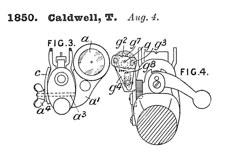
The side-mounted fore-sight unit
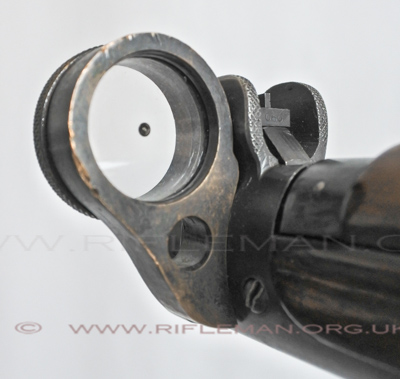 ..........................
.......................... 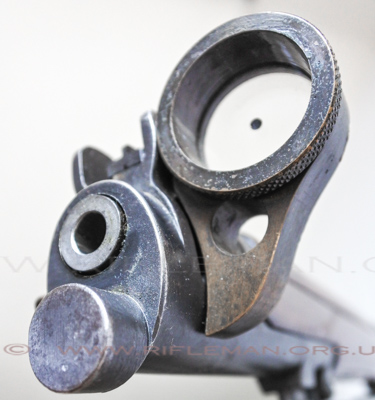
The fore-sight is clamped through the oval lightening aperture of the nose-cap
with a shaped recessed block spacer on which fastening the wing-nut bears.
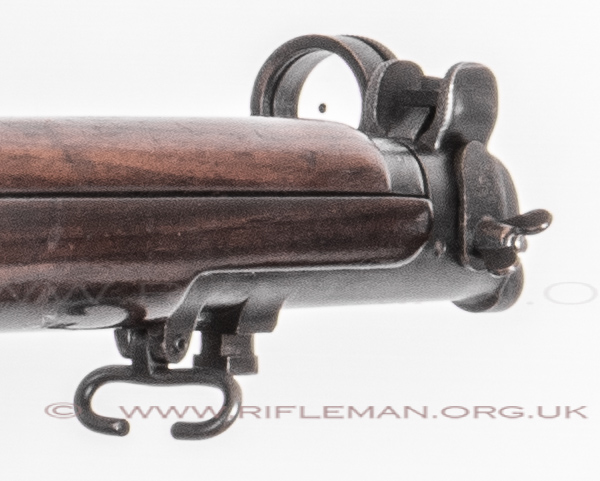
And the rear-sight, which can be folded either backward or forward.
The swivelling plate on the rear face is to blank off the aperture,
protecting the rear of the lens from dust ingress.
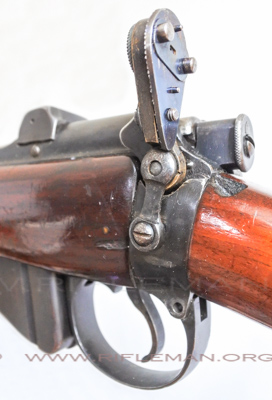 ..........................
.......................... 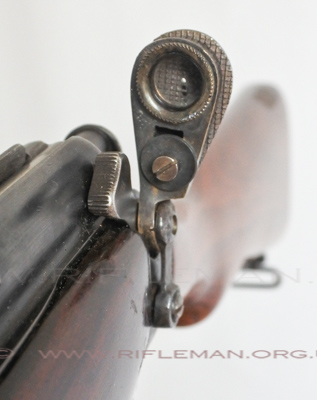
Early sights were graduated to 200 yards, but the later models went up to 600 yards.
The sight picture
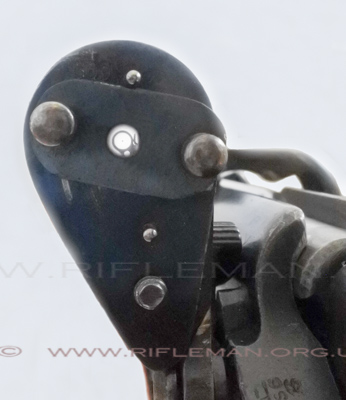
See also: the LATTEY Galilean sights on the SMLE.....GIBBS Galilean sights for the SMLE...
MARTIN Galilean sights for the SMLE .........BSA optical sight on a Lee-Metford
Return to: TOP of PAGE
See this website's Raison d'être